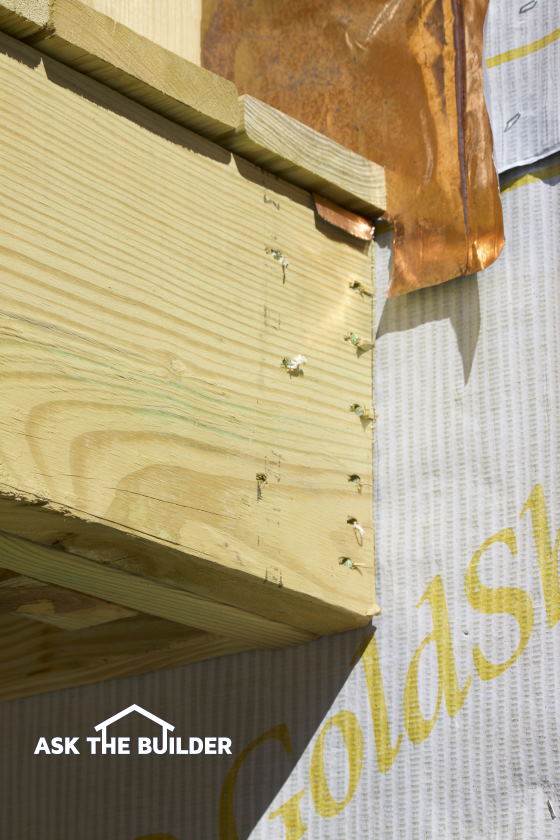Deck-Building No-No and Washing Windows

Deck Building | This outer deck joist is not safe. No structural engineer would ever approve this method. Copyright 2020 Tim Carter
Deck-Building No-No
QUESTION #1: Tim, I need your help. I contracted with a large home center to have a deck built. I came home from work and saw that the carpenters had toenailed an outer joist to the side of my home. Many of the nails are close to the edge and I can already see some splitting of the wood. The deck railing post is connected to this joist and I’m worried about its strength. What’s the right way to make this connection? How would you have done it? Amber T., Memphis, TN
Amber sent me a photograph of the flawed workmanship. It shook me to the core. I also saw serious errors made in how the ledger board was attached to the house and how the flashing was applied.
Several years ago, I attended a one-day workshop put on by the top deck hardware manufacturer in the USA. One of the statistics floated at the workshop was the number of defective decks in the USA. They estimated it to be higher than eighty percent. Deck collapses are in the local news all the time. The Internet is littered with stories of collapses. Just a year ago, it became somewhat personal for me because a friend of my daughter almost died from a deck collapse. She broke her neck and ruptured her spleen.
Here’s an autopsy report on what I saw from Amber’s photo. First, there were two joists at the end of the deck. The first one, no doubt, was nailed into the end grain of the ledger board. This is the weakest of all connections because the holding power of end grain is far lower than the holding power of a fastener installed 90 degrees to the end grain.
The visible nails used were installed by a nail gun. They may have a thin coating of galvanizing on them. Newer treated lumber has a higher copper content and it requires very special fasteners that have a much thicker coating of galvanizing to resist corrosion. When you purchase fasteners, most have an exposure rating on the label. Always purchase ones with the highest level of corrosion resistance.
Toenailing a horizontal beam to a wall is simply unacceptable. The nails shot by the nail gun were probably no longer than 3 inches and when you do the math, maybe just 3/4 of an inch of the nail passed through the outer oriented strand board of the house into who-knows-what.
There are all sorts of approved ways to connect this double joist at the end of the deck. The ledger board could have extended another 6 inches and then a double joist hanger could have supported the two joists. Special structural screws should be used to attach the joist hanger to the ledger, not nails.
The flashing detail is on my AsktheBuilder.com website. Go there and behold the magic discovered over a hundred years ago about fire cuts and how you can employ those to keep water out of your house when you flash up from a deck ledger board, over it, and down the face of it.
Washing Windows
QUESTION #2: Hey Tim, I wonder what you know about washing windows. No matter what I try, the blue liquid, ammonia, paper towels, newspapers, etc. I get streaks. Can you help me? I’m tired of dirty glass and am more frustrated than an inebriated person trying to get a key in a door lock! Terri A., Columbus, OH
I know all about being frustrated by dirty glass and door locks. I also know how to get glass perfectly clean. I used to watch a professional window washer clean the giant plate-glass windows at the chili parlor I worked at in high school and college. However, I didn’t pay close attention to the actual process as I was too busy making cheese coneys.
Years ago, I decided to discover how professionals clean glass, acres of glass. I called the presidents of two of the largest window-washing companies in the USA. These are the companies that clean windows on skyscrapers. The answers from both were identical and I hung up the phone thinking, “There’s no way it can be that simple.”
Both men said the secret is to use regular water with a small amount of liquid dish soap in it. You can purchase special window-washing soaps for this purpose if you want. The second-most important thing is to use the correct tool to clean the glass. Pros use a lambs-wool tool that they rub across the glass. This tool is soaked in the water solution and the sweeping motions the pros use gets the dirt off the glass.
The brass squeegee you see the pros use is not a magic tool that’s cleaning the glass. It’s just removing the left-behind water! The pros will also use a rag to wipe any excess water from the edges of the glass. I use this method and my glass here at my house is spotless.
The blue liquid, ammonia, and all those other home-methods are just a waste of time. If they worked, don’t you think you’d see the pros use them? After all, the faster and better they can clean glass the more money they make. There’s a reason you never see a pro use blue liquid and paper towels or rags. It’s laughable when you think about it!
Column 1345
2 Responses to Deck-Building No-No and Washing Windows